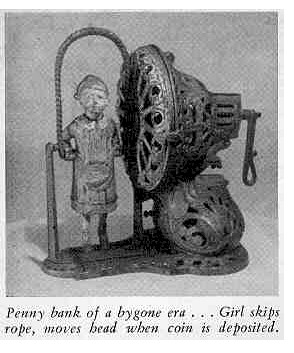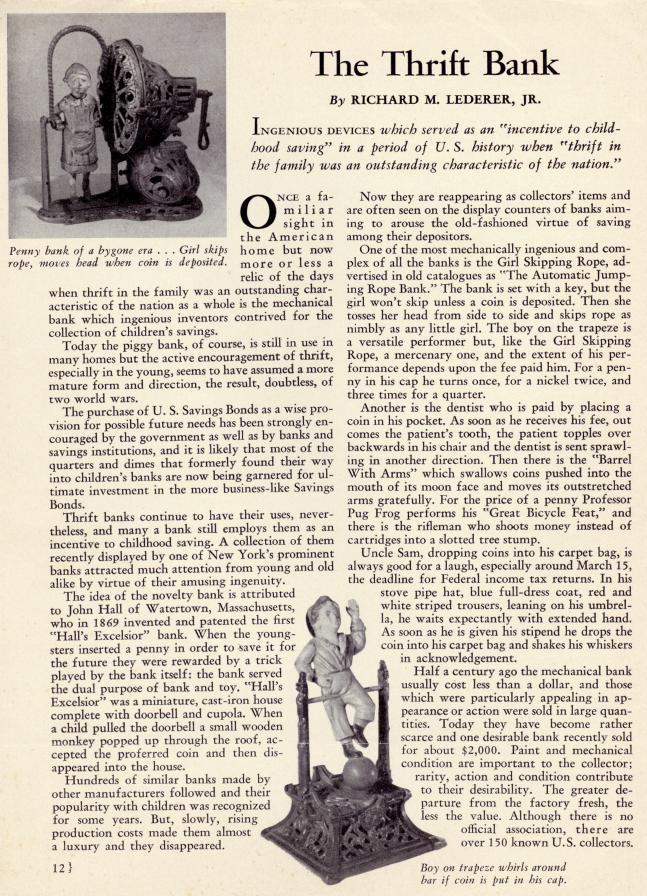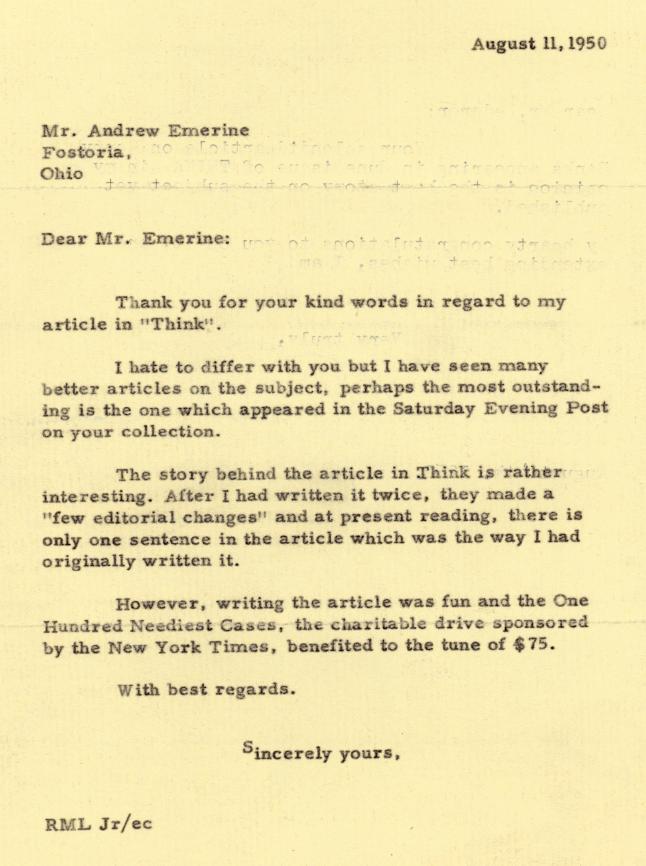The Thrift Bank
By RICHARD M. LEDERER, JR. — I.B.M. Magazine, THINK, June, 1950
INGENIOUS DEVICES which served as an "incentive to childhood saving" in a period of U.S. history when "thrift in the family was an outstanding characteristic of the nation."
 ONCE a familiar sight in the
American home but now more or less a relic of the days when thrift in the family was an
outstanding characteristic of the nation as a whole is the mechanical bank which ingenious
inventors contrived for the collection of children’s savings.
ONCE a familiar sight in the
American home but now more or less a relic of the days when thrift in the family was an
outstanding characteristic of the nation as a whole is the mechanical bank which ingenious
inventors contrived for the collection of children’s savings.
Today the piggy bank, of course, is still in use in many homes but the active encouragement of thrift, especially in the young, seems to have assumed a more mature form and direction, the result, doubtless, of two world wars.
The purchase of U.S. Savings Bonds as a wise provision for possible future needs has been strongly encouraged by the government as well as by banks and savings institutions, and it is likely that most of the quarters and dimes that formerly found their way into children’s banks are now being garnered for ultimate investment in the more business-like Savings Bonds.
Thrift banks continue to have their uses, nevertheless, and many a bank still employs them as an incentive to childhood saving. A collection of them recently displayed by one of New York’s prominent banks attracted much attention from young and old alike by virtue of their amusing ingenuity.
The idea of the novelty bank is attributed to John Hall of Watertown, Massachusetts, who in 1869 invented and patented the first "Hall’s Excelsior" bank. When the youngsters inserted a penny in order to save it for the future they were rewarded by a trick played by the bank itself: the bank served the dual purpose of bank and toy, "Hall’s Excelsior" was a miniature, cast-iron house complete with doorbell and cupola. When a child pulled the doorbell a small wooden monkey popped up through the roof, accepted the profered coin and then disappeared into the house.
Hundreds of similar banks made by other manufacturers followed and their popularity with children was recognized for some years. But, slowly, rising production costs made them almost a luxury and they disappeared.
Now they are reappearing as collector’s items and are often seen on the display counters of banks aiming to arouse the old-fashioned virtue of saving among their depositors. One of the most mechanically ingenious and complex of all the banks is the Girl Skipping Rope, advertised in old catalogues as "The Automatic Jumping Rope Bank." The bank is set with a key, but the girl won’t skip unless a coin is deposited. Then she tosses her head from side to side and skips rope as nimbly as any little girl. The boy on the trapeze is a versatile performer but, like the Girl Skipping Rope, a mercenary one, and the extent of his performance depends upon the fee paid him. For a penny in his cap he turns once, for a nickel twice, and three times for a quarter.
Another is the dentist who is paid by placing a coin in his pocket. As soon as he receives his fee, out comes the patient’s tooth, the patient topples over backwards in his chair and the dentist is sent sprawling in another direction. Then there is the "Barrel With Arms" which swallows coins pushed into the mouth of its moon face and moves its outstretched arms gratefully. For the price of a penny Professor Pug Frog performs his "Great Bicycle Feat," and there is the rifleman who shoots money instead of cartridges into a slotted tree stump.
Uncle Sam, dropping coins into his carpet bag, is always good for a laugh, especially around March 15, the deadline for Federal income tax returns. In his stove pipe hat, blue full-dress coat, red and white striped trousers, leaning on his umbrella, he waits expectantly with extended hand. As soon as he is given his stipend he drops the coin into his carpet bag and shakes his whiskers in the acknowledgement.
Half a century ago the mechanical bank usually cost less than a dollar, and those which were particularly appealing in appearance or action were sold in large quantities. Today they have become rather scarce and one desirable bank recently sold for about $2,000. Paint and mechanical condition are important to the collector; rarity, action and condition contribute to their desirability. The greater departure from the factory fresh, the less the value. Although there is no official association, there are over 150 known U.S. collectors.



| Andrew Emerine A COLLECTOR Fostoria Ohio Dear Mr. Lederer; Your splendid article on Penny Banks appearing in June issue of THINK in my opinion is the best story on the subject yet published. My hearty congratulations to you on it, and extending best wishes, I am Very truly Andrew Emerine August 4th. 1950.
|
